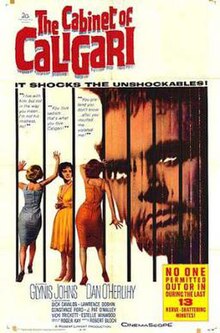The Cabinet of Caligari
| The Cabinet of Caligari | |
|---|---|
 Theatrical release poster | |
| Directed by | Roger Kay |
| Written by | Robert Bloch |
| Produced by | Roger Kay |
| Starring | |
| Cinematography | John L. Russell |
| Edited by | Archie Marshek |
| Music by | Gerald Fried |
| Distributed by |
|
Release date | May 25, 1962 |
Running time | 105 min. |
| Countries |
|
| Language | English |
| Budget | $1 million[1] |
The Cabinet of Caligari is a 1962 American
Although the film's title is very similar to the German silent horror film The Cabinet of Dr. Caligari (1920), it shares very few similarities except for the main plot twist. The film's script was written by Robert Bloch, author of the novel Psycho. The cinematographer for The Cabinet of Caligari was John L. Russell, who also worked on Alfred Hitchcock's film Psycho (1960).
Plot
Motorist Jane Lindstrom (Glynis Johns) has a tire blowout and seeks assistance at an estate owned by Caligari (Dan O'Herlihy), a very polite man with a Swedish accent. After spending the night there, she finds that Caligari will not let her leave; he proceeds to ask some personal questions and shows her pictures that offend her.
Prevented by guards from leaving and unable to use the telephone, Jane seeks allies among the other guests. She finds only three possible candidates: the older Paul, the younger Mark (
Finally, it is revealed that Jane is a mental patient and everything the audience has seen up to this point has been her distortion of the institute she was in: the personal questions were
Cast
- Glynis Johns as Jane
- Dan O'Herlihy as Paul/Caligari
- Dick Davalosas Mark
- Lawrence Dobkin as David
- Constance Ford as Christine
- Estelle Winwood as Ruth
- J. Pat O'Malley as Perkins
Production
This section may need to be rewritten to comply with Wikipedia's quality standards. (May 2018) |
Kay used a colour chart when making the film. He went through the script and allocated a colour representing the emotion the audience was to feel.[1]" The new Caligari is completely modern", said Kay during filming. "I don't want to sound presumptuous but I am trying to get the Pirandello approach that says nothing is what it appears to be. The thesis behind the damsel in distress, behind the little thrills and shocks is, What is reality?"[1]"This picture is going to cause a lot of talk", said Lippert.[1] Dexter says once he read the script and saw how different the film would be from the original, he advised Lippert to fire Kay, but Lippert backed the director. He also says Kay yelled at Glynis Johns during filming and Johns ran off the set; Lippert forced Kay to apologize so filming could continue.[9]
Reception
According to Dexter, the film was a critical and financial failure.[9]
In 1963, Kay said he "disowns" the film, blaming Fox for turning it into a "lurid, sex charged picture" and claiming the version released was "considerably different" from his version. He said a copy of his original cut was with the Museum of Modern Art.[10]
Lippert wanted to reunite O'Herlihy and Johns in an adaptation of Trilby,[11] but no film resulted.
See also
References
- ^ ProQuest 115309922.
- ProQuest 167928419.
- ISBN 0312853734.
- ProQuest 167973654.
- ISBN 0312853734.
- ISBN 9780786482153. Archived from the original on 20 April 2023. Retrieved 27 October 2020 – via Google Books.
- ProQuest 141473377.
- ProQuest 115284670.
- ^ a b c Dexter, Maury (2012). Highway to Hollywood (PDF). p. 103. Archived (PDF) from the original on 4 March 2016. Retrieved 9 March 2018.
- ProQuest 168317180.
- ProQuest 141681306.
